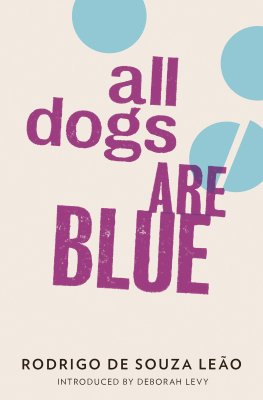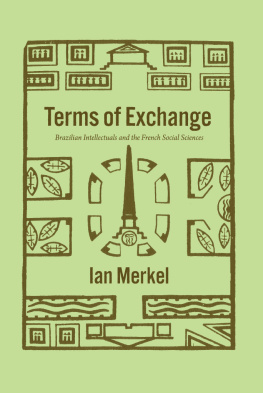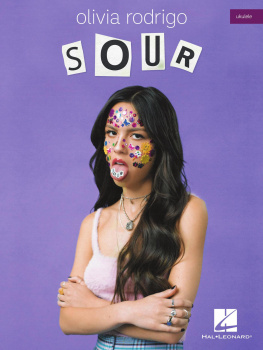Rodrigo Leao - All Dogs are Blue
Here you can read online Rodrigo Leao - All Dogs are Blue full text of the book (entire story) in english for free. Download pdf and epub, get meaning, cover and reviews about this ebook. year: 2013, publisher: And Other Stories Publishing, genre: Prose. Description of the work, (preface) as well as reviews are available. Best literature library LitArk.com created for fans of good reading and offers a wide selection of genres:
Romance novel
Science fiction
Adventure
Detective
Science
History
Home and family
Prose
Art
Politics
Computer
Non-fiction
Religion
Business
Children
Humor
Choose a favorite category and find really read worthwhile books. Enjoy immersion in the world of imagination, feel the emotions of the characters or learn something new for yourself, make an fascinating discovery.
- Book:All Dogs are Blue
- Author:
- Publisher:And Other Stories Publishing
- Genre:
- Year:2013
- Rating:3 / 5
- Favourites:Add to favourites
- Your mark:
- 60
- 1
- 2
- 3
- 4
- 5
All Dogs are Blue: summary, description and annotation
We offer to read an annotation, description, summary or preface (depends on what the author of the book "All Dogs are Blue" wrote himself). If you haven't found the necessary information about the book — write in the comments, we will try to find it.
All Dogs are Blue — read online for free the complete book (whole text) full work
Below is the text of the book, divided by pages. System saving the place of the last page read, allows you to conveniently read the book "All Dogs are Blue" online for free, without having to search again every time where you left off. Put a bookmark, and you can go to the page where you finished reading at any time.
Font size:
Interval:
Bookmark:
Rodrigo Souza Leao
All Dogs are Blue
For Leonardo Gandolfi, Franklin Alves Dassie, Silvana Guimares and Iosif Landau
Introduction
Shed fallen in love with the craziness in me.
Sometimes lunatics are very seductive.
All Dogs are Blue is a comic modernist novel about being messed up and then being messed up even more by numbing doses of pharmaceuticals. Rodrigo de Souza Leo is very clear about what has happened to his thirty-six-year-old narrator. He has swallowed a chip, and the chip makes him do things he doesnt want to do. Set in a mental asylum in Rio de Janeiro, Souza Leos autobiographical last novel is about a whole lot of other things too: the drunken street sweepers from the favelas who somehow also end up in the asylum; the narrators teenage years growing up bookish and paranoid; his kindly parents who are pushed to the limits of their empathy and endurance; a blue toy dog which is both childhood companion and the colour of the narrators medication. It may also refer to the better-known black dog of melancholia but your everyday black dog is just a mutt, whereas Souza Leos blue dog is a rare breed.
Rest assured that we are in the hands of the most reliable of narrators, despite his illness which is diagnosed as belonging to the family of schizophrenias. Whatever, he totally knows the score: Why do all crazy people have the same paranoias? Thats a reliably interesting question. Reliable? Doesnt he turn himself into a plant? Yes, he is reliably crazy. But he is also reliably lucid, astute and witty. He doesnt attempt to delude his readers so much as try to get a grip on his own delusions. If he is coshed into silence by the high doses of medication bayoneted into his veins, he is also reliably vocal about the experience about what its all for: all this to keep a state of order. Were the minority, but at least I say what I want. He is sad about his situation (its no joke), yet he is intellectually switched on and reliably spirited.
Souza Leo is a mind-blowing poet; his attitude seems to be something like: Why not flaunt the language(s) that madness has taught me? If Im tri-lingual and didnt even have to pay a tutor or travel agent to pick up the lingo, thats the pay-off for all this suffering. He was aware that he had to use everything his illness had given him in order to write and everything it had taken away from him too. To help him get through his day in the asylum, our narrator hallucinates two friends: one is called Rimbaud and, when hes not riding an elephant to Africa, he is on-side and loyal; the other is Baudelaire, but hes more of a fair-weather friend and can be unsociable.
In May 1871, aged sixteen, Rimbaud wrote a letter to his teacher, Georges Izambard, explaining his teenage poetic philosophy:
Im now making myself as scummy as I can. Why? I want to be a poet, and Im working at turning myself into a seer. You wont understand any of this, and Im almost incapable of explaining it to you. The idea is to reach the unknown by the derangement of all the senses. It involves enormous suffering, but one must be strong and be a born poet. Its really not my fault. (trans Graham Robb, 2000)
Rodrigo de Souza Leo would have been aware of this letter it might have helped him figure that the (involuntary) derangement of his own senses was not useless material. His narrator tells us of his own teenage years, in which he sounds a little like Rimbaud: I was possessed by a fertile spirit of modern madness, one that has helped twentieth-century poetry many times.
Its not all about art though. The always-horny narrator often makes his father cry. His mother brings him tuna sandwiches to the hospital but she doesnt want him to come home. If life in an insane asylum is actually very dull, Souza Leos subtle achievement is that he evokes the dull and deadening days without ever being boring or making them more exotic than they are. Everything that is interesting about the novel can be found in its light, laconic tone. Above all, this is a novel driven by tone. In this sense it reminds me of Houellebecqs first novel, Extension du domaine de la lutte, or Whatever.
Souza Leos narrator doesnt know which is more of a nightmare, waking or sleeping but when he is awake he always gives cigarettes to the lunatic who bangs his head against the wall. He wonders what would happen if the lunatic were a footballer: His headers would be unstoppable. After all that banging his head against walls, hed slam in headers from anywhere. Maybe hed get called up to play for Brazil.
The narrator wakes up one day wanting to say beautiful things. He picks a flower in the garden and takes it back to his room. The nurse asks him if hes gone gay. The asylum gardens are full of butterflies. Slums surround the asylum and he can hear music playing day and night. In All Dogs are Blue, the lives of the poor and the insane are knotted together. The father figure is knotted together too. From his bed, he can see the Christ statue on the hill. Maybe its the sun setting, maybe its the injections, but Christ seems to be always golden. When he kisses his own fathers face, he wonders, Is it the kiss of Judas? Will I betray my father in my madness? A feral murderer is admitted to the asylum. He terrifies everyone and shits wherever he likes. Yet this murderer is scared of the fragile shape-shifting narrator (medication has made him fat and bloated) because his voice reminds him of his own father who beat him.
All Dogs are Blue knows that it is telling us about the layers of language at play in both poetry and psychosis. In this sense, the spare, poetic prose won from the original Portuguese in this translation by Stefan Tobler and Zo Perry is a breathtaking achievement. Thanks to their skill, we hear Souza Leos multiple associations building, and if we want to, we will find a network of signifiers linking words with other words. Or we can just go with the story and enjoy its exuberance.
The first chapter of the novel is ironically titled It all went Van Gogh. Perhaps Leo had read the poet and playwright Antonin Artauds luminous essay titled Van Gogh: the man suicided by society. Here is what Artaud said about the psychiatry of his generation:
In comparison with the lucidity of Van Gogh, which is a dynamic force, psychiatry is no better than a den of apes who are themselves obsessed and persecuted and who possess nothing to mitigate the most appalling states of anguish and human suffocation but a ridiculous terminology,
worthy product of their damaged brains.(trans Helen Weaver, 1976)
In this essay, Artaud (who had also spent time in mental institutions) found a startling poetic image to describe Van Goghs state of mind and perhaps his own. Artaud believed that the bullet that killed Van Gogh was in his stomach before he shot himself, that it was already there while he was painting black crows smashing against the purple sky of Arles. In other words, Van Gogh was already committed to death before it happened. Artauds subversive notion of this bending of existential time leads to the kind of sorrow that can be too painful to accept unless the writer is calmly onside with the reader. All Dogs are Blue never deals out this sort of sorrow. Life is lived intensely and with gusto at the asylum in Rio. All Dogs are Blue kept me curious and it kept me laughing, especially when the evangelicals recruiting patients to the cause leave a leaflet near the narrators bed: My God! Fundamentalists are taking over the world. Theyre even coming here to recruit the utterly fucked.
When Souza Leo was completing this book, he deleted words and paragraphs, structured the pages, pasted and copied and redrafted. Like all writers, he read his manuscript through and made decisions. He knew what he had to do to craft this unforgettable novel. His title suggests that we will encounter a stretch of writing in which reality slips and slides, yet always returns to something recognisable. As for the magnificent last line in this most valuable book (but dont look now) Im still thinking about it.
Font size:
Interval:
Bookmark:
Similar books «All Dogs are Blue»
Look at similar books to All Dogs are Blue. We have selected literature similar in name and meaning in the hope of providing readers with more options to find new, interesting, not yet read works.
Discussion, reviews of the book All Dogs are Blue and just readers' own opinions. Leave your comments, write what you think about the work, its meaning or the main characters. Specify what exactly you liked and what you didn't like, and why you think so.












